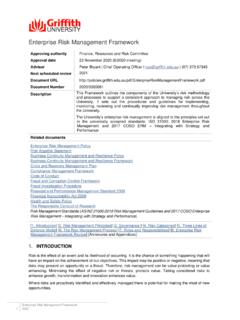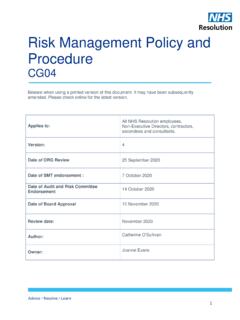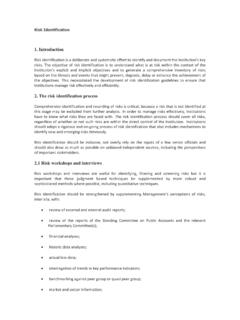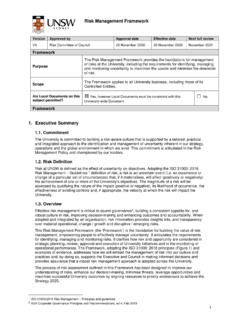Transcription of A Risk Based Thinking Model for ISO 9001:2015
1 2014 QSG, Risk Based Thinking Model for ISO 9001: 2015 Bob DeysherSenior Consultant 2014 QSG, Inc. 2014 QSG, 15, 20152 Why implement Risk Based Thinking ? What does ISO 9001: 2015 require? What is Risk Based Thinking ? What is Risk? What is a simple Risk Tool? How does it integrate into the Process Approach? How do you make Risk Based Thinking a Continual Process Improvement activity? 2014 QSG, 9001: 2015 Risk & OpportunitiesJanuary 15, Quality management system and its processesThe organization shall establish, implement, maintain and continually improve a quality management system, including the processes needed and their interactions, in accordance with the requirements of this International organization shall determine the processes needed for the quality management system and their application throughout the organization and shall determine:f) the risks and opportunities in accordance with the requirements of , and plan and implement the appropriate actions to address them.
2 2014 QSG, 9001: 2015 Risk & OpportunitiesJanuary 15, 201546 Planning for the quality management Actions to address risks and When planning for the quality management system,the organization shall consider the issues referred toin and the requirements referred to in anddetermine the risks and opportunities that need to beaddressed to:a) give assurance that the quality managementsystem can achieve its intended result(s); b) prevent, or reduce, undesired effects;c) achieve continual improvement. 2014 QSG, 9001: 2015 Risk& OpportunitiesJanuary 15, The organization shall plan:a) actions to address these risks and opportunities;b) how to:1) integrate and implement the actions into itsquality management system processes ( );2) evaluate the effectiveness of these taken to address risks and opportunities shall be proportionate to the potential impact on the conformity of products and services.
3 2014 QSG, Main Objectives of International StandardsJanuary 15, 20156 To provide confidence in the organization s ability to consistently provide customers with conforming goods and services To enhance customer satisfactionThe concept of risk in the context of the international standards relates to the uncertainty in achieving these objectives 2014 QSG, is Risk Based Thinking ?January 15, 20157 2014 QSG, is Risk- Based Thinking ?January 15, 20158 Risk- Based Thinking is something we all do automatically and often sub-consciously The concept of risk has always been implicit in ISO 9001 the 2015 revision makes it more explicit and builds it into the whole management system Risk- Based Thinking is already part of the process approach Risk- Based Thinking makes preventive actionpart of the routine Risk is often thought of only in the negative sense.
4 Risk- Based Thinking can also help to identify opportunities. This can be considered to be the positive side of risk 2014 QSG, Should I adopt Risk- Based Thinking ?January 15, 20159 To improve customer confidence and satisfaction To assure consistency of quality of goods and services To establish a proactive culture of prevention and improvement Successful companies intuitively take a risk- Based approach 2014 QSG, Should I Do?January 15, 201510 Identify what the risks and opportunities are in yourorganization it depends on context ISO 9001: 2015 will not automatically require you to carry out a full, formal risk assessment, or to maintain a risk register ISO 31000 ( Risk management Principles and guidelines ) will be a useful reference (but not mandated) 2014 QSG, Should I Do? (continued)January 15, 201511 Analyse and prioritize the risks and opportunities in your organization what is acceptable?
5 What is unacceptable? Plan actions to address the risks how can I avoid or eliminate the risk? how can I mitigate the risk? Implement the plan take action Check the effectiveness of the actions does it work? Learn from experience continual improvement 2014 QSG, Points to Remember January 15, 201512 Risk Based Thinking = Preventative ActionRisk Based Thinking is everybody s business! Risk Based Thinking is not just the responsibility of management Risk Based Thinking must become an integral part of the organizational culture 2014 QSG, is Risk?January 15, 201513 Risk is the possibility of events or activities impeding the achievement of an organization s strategic and operational objectives. 2014 QSG, A Simple DefinitionJanuary 15, 201514 The volatility of potential surprised do you really want to be?
6 ? 2014 QSG, for ThoughtJanuary 15, 201515 Why is Risk like Swiss Cheese?Author needs to acknowledge that this idea was shown at the NQA Meeting, Boston Session, August 2014 2014 QSG, DefinitionsJanuary 15, 201516 Risk can be defined by two (2) parameters Severity This is theSeriousness of the harm Probability This is the Probabilitythat the harm will occur 2014 QSG, Assessment -QuantitativeJanuary 15, 201517 2014 QSG, Acceptable RegionsJanuary 15, 201518 Generally AcceptableGenerally Un-AcceptableAs Low As PracticalAs Low As Reasonably Practical 2014 QSG, Assessment -QualitativeJanuary 15, 201519 2014 QSG, RegistersJanuary 15, 201520 2014 QSG, Importance of a Risk RegisterJanuary 15, 201521 The risk register or risk log becomes essential as it records identified risks , their severity, and the actions steps to be taken.
7 It can be a simple document, spreadsheet, or a database system, but the most effective format is a table. A table presents a great deal of information in just a few pages. 2014 QSG, of a Risk RegisterJanuary 15, 201522 There is no standard list of components that should be included in the risk register . Some of the most widely used components are: Dates: As the register is a living document, it is important to record the date that risks are identified or modified. Optional dates to include are the target and completion dates. Description of the Risk:A phrase that describes the risk. Risk Type (business, project, stage): Classification of the risk: Business risks relate to delivery of achieved benefit;, project risks relate to the management of the project such as timeframes and resources, and stage risks are risks associated with a specific stage of the plan.
8 Likelihood of Occurrence: Provides an assessment on how likely it is that this risk will occur. Examples are: L-Low >30%)(, M-Medium (31-70%), H-High (>70%). Severity of Effect: Provides an assessment of the impact that the occurrence of this risk would have on the project. 2014 QSG, of a Risk RegisterJanuary 15, 201523 There is no standard list of components that should be included in the risk register . Some of the most widely used components are: Countermeasures: Actions to be taken to prevent, reduce, or transfer the risk. This may include production of contingency plans. Owner: The individual responsible for ensuring that risks are appropriately engaged with countermeasures undertaken. Status: Indicates whether this is a current risk or if risk can no longer arise and impact the project. Example classifications are: C-current or E-ended.
9 Other columns such as quantitative value can also be added if appropriate. 2014 QSG, registers -ExampleJanuary 15, 201524 2014 QSG, registers -ExampleJanuary 15, 201525 2014 QSG, Risk Based Thinking with the Process Approach January 15, 201526 2014 QSG, of the Process ApproachJanuary 15, 201527 The purpose of the process approach is to enhance an organization seffectiveness and efficiencyin achieving its defined objectives. This means enhancing customer satisfaction by meeting customer requirements. 2014 QSG, This a Process Model in Your Organization?January 15, 201528 2014 QSG, does your Process Approach look like this?January 15, 201529 2014 QSG, does your Process Approach look like this?January 15, 201530 2014 QSG, (Major Elements & Boundaries)StartEndProcess Owners:OutputsCustomers(for Whom?)InputsSuppliers(By Whom)Materials(With What?)
10 Measures(Trend Charts)(Metrics)Manpower(Training)(Skill s)Methods(How?)Machine(With What?)Environment (Area Conditions?) risks (What Can Go Wrong?)January 15, 201531 2014 QSG, Risk ModelJanuary 15, 201532 2014 QSG, Risk Model -Populated January 15, 201533 New Risk Value Post Action Plans 2014 QSG, for ThoughtJanuary 15, 201534 Why is Risk like Swiss Cheese?Author needs to acknowledge that this idea was shown at the NQA Meeting, Boston Session, August 2014 2014 QSG, RiskJanuary 15, 201535 2014 QSG, Risk Based Thinking with the Process Approach and PDCAJ anuary 15, 201536 2014 QSG, 15, 201537 The Plan-Do-Check-Act (PDCA) methodology can be a useful tool to define, implement and control corrective actions and improvements. Extensive literature exists about the PDCA cycle in numerous What to do? How to do it?Do Do what wasplannedCheck Did things happenaccording to plan?










